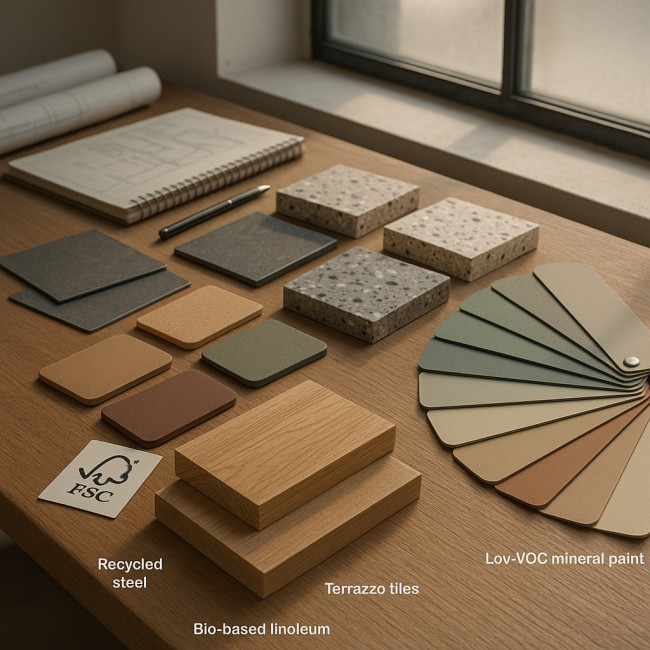Sustainable Material Guide for Interior Architects: Specify Finishes Clients Love
Need to nail a finish schedule that delights clients, protects the planet and keeps contractors on budget? This guide breaks down proven sustainable materials, the certifications that back them, real-world cost ranges and step-by-step tips to win approvals faster.
Why Sustainable Finishes Matter in 2025

From ESG reporting to employee well-being, interior projects now carry environmental KPIs alongside aesthetics and budget. A finish that looks great but scores poorly on embodied carbon or VOC emissions can tank tender results or trigger expensive redesigns. Forward-thinking practices pivot toward low-impact materials early, turning sustainability into a competitive edge rather than a late-stage headache.
Key Criteria When Specifying Eco-Friendly Materials
Embodied Carbon
Measure the greenhouse gases released across extraction, manufacturing and transport. Tools such as EC3 or One Click LCA help benchmark kg CO₂e per square metre.
Certifications & Traceability
Labels like FSC, Cradle to Cradle, or Declare give third-party proof. Recycled metal suppliers can also provide eco-certified mill certificates that impress auditors.
Indoor Air Quality (IAQ)
Low-VOC or zero-formaldehyde formulations keep occupants healthy. LEED v4.1 and WELL v2 both reward materials with verified emission scores.
Durability & End-of-Life
Products that last longer or separate easily for recycling cut total carbon over the building life cycle. Bio-based linoleum, for instance, composts safely, while recycled steel can be remelted indefinitely.
Top Sustainable Finish Options Clients Already Love
FSC-Certified Timber Panels
- Applications: wall cladding, acoustic baffles, bespoke joinery.
- Why clients say yes: warm tactility and carbon sequestration messaging.
- Specification tip: request chain-of-custody paperwork before shop drawings.
Recycled Steel Sheets
- Applications: feature ceilings, bar fronts, stair balustrades.
- Why clients say yes: robust, fire-safe, industrial chic.
- Specification tip: confirm post-consumer content ≥ 70 % to unlock GWP savings.
Bio-Based Linoleum Flooring
- Applications: high-traffic corridors, healthcare spaces.
- Why clients say yes: plant-rich make-up, subtle colourways, self-repairing surface.
- Specification tip: ask for factory-applied finish to minimise on-site chemicals.
Terrazzo With Recycled Aggregate
- Applications: lobby floors, countertops, statement stairs.
- Why clients say yes: tailored colour chips, heritage vibe minus quarry waste.
- Specification tip: specify local waste glass or porcelain to cut haulage miles.
Low-VOC Mineral Paints
- Applications: all internal walls, especially wellness areas.
- Why clients say yes: breathable, mould-resistant, odour-free handover.
- Specification tip: insist on ≤ 1 g/L VOC to meet WELL thresholds.
Quick-Scan Comparison Table
| Finish | Typical Use | Key Certification | Average Cost €/m² |
|---|---|---|---|
| FSC Timber Panels | Wall & ceiling cladding | FSC 100% | 45 – 70 |
| Recycled Steel | Feature metalwork | Recycled Content ≥70 % | 60 – 95 |
| Bio-based Linoleum | Resilient flooring | Cradle to Cradle Gold | 35 – 55 |
| Recycled Terrazzo | Counters & floors | GREENGUARD Gold | 75 – 110 |
| Mineral Paint | Wall finish | EU Ecolabel | 4 – 8 |
Embodied Carbon Snapshot
Source : Circular Ecology Database
Three Workflow Moves That Impress Eco-Conscious Clients
- Material passports: log supplier, batch, embodied carbon and end-of-life route in BIM objects. This transparency speeds up client approval and aligns with upcoming EU taxonomy rules.
- Mock-up days with impact data: present physical samples alongside a one-page carbon and VOC scorecard. Stakeholders grasp trade-offs instantly.
- Future-proof budgets: add a 5 % contingency line for recycled or bio-based material lead times. Early clarity prevents value-engineering later.
Case-Study Inspiration
Need evidence? Browse award-winning spatial designers who publish bill-of-materials snapshots inside their project pages. The format is bite-size yet proves measurable impact.
For furniture or object details, pair this guide with sustainable sourcing plans for object designers to ensure a cohesive low-carbon narrative throughout the specification set.
Next-Level Resources
- Need to tackle exhibition builds? Check the eco-smart materials roadmap for scenography.
- Renovating historic interiors? Review soil-safe material lists for outdoor-to-indoor transitions.
Knowledge Check: Quick Quiz
FAQ
- How do I prove embodied carbon savings to investors?
- Include Environmental Product Declarations (EPDs) for each specified material and summarise the total kg CO₂e reduction versus a baseline specification.
- Are bio-based finishes less durable?
- Modern linoleum, mineral paints and plant-oil sealers achieve comparable lifespans to conventional alternatives when installed and maintained per manufacturer guidelines.
- Can I combine recycled metals with FSC timber without galvanic issues?
- Yes. Apply a clear isolating primer between steel and wood, or specify stainless fixings to prevent corrosion at joints.
- What if a client refuses premium pricing for sustainable options?
- Present life-cycle cost analysis showing maintenance savings and potential tax incentives that often offset the 3–8 % upfront uplift.
Ready to Specify Finishes Clients Brag About?
Download our editable finish schedule template and share it with your QS this week. You'll cut research time by half and widen your lead pipeline with results that speak for themselves.











